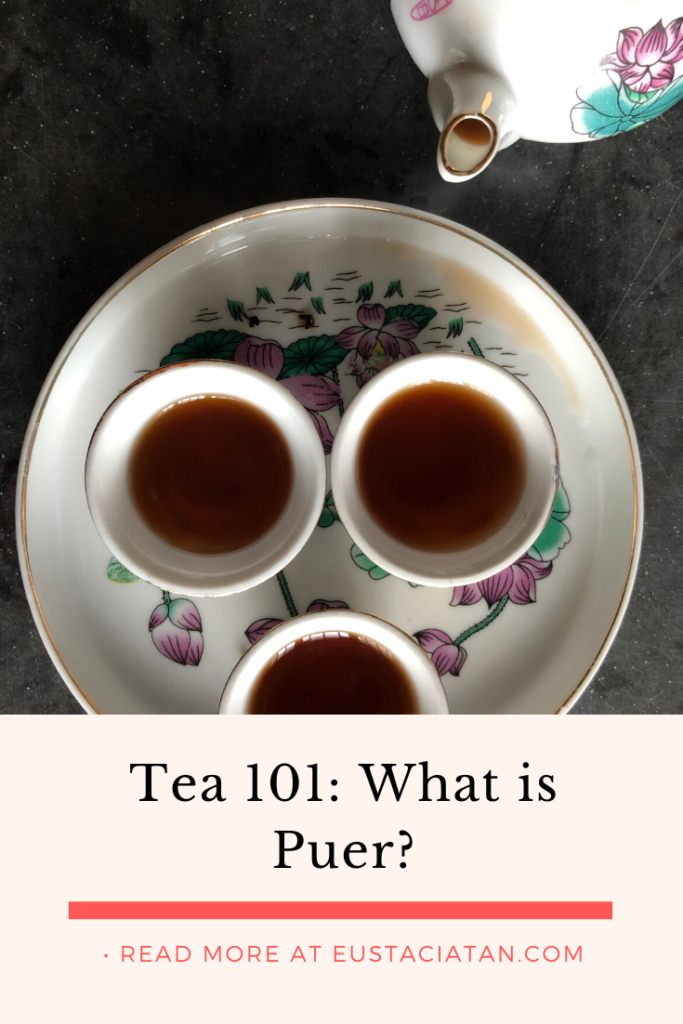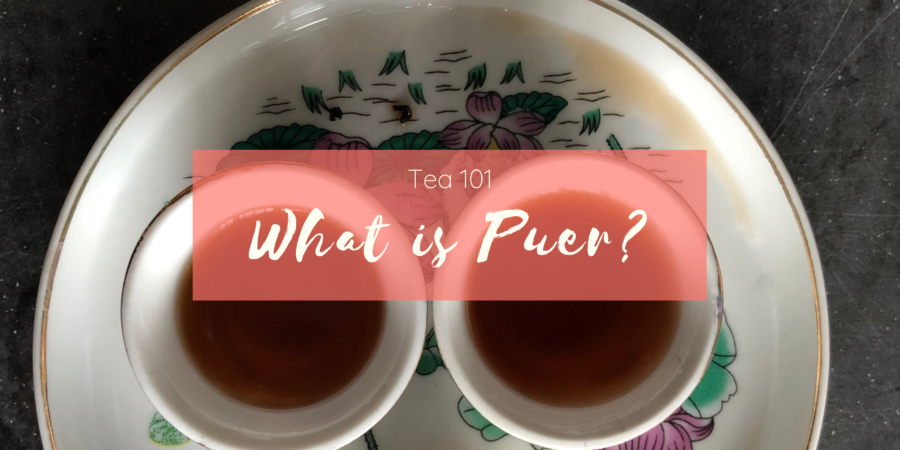Inspired by my recent tea experiment with rose puer cakes and an upcoming tea session involving Malawi puer, I thought it would be fun to go back to basics and explore the idea: what is puer?
Introduction
In many tea books I’ve read, tea is often classified as: green, black, oolong, yellow (sometimes left out), white, and puer. Books that go deeper in the subject tend to add in “dark tea”, of which puer is a subset, but even then, many of the books will discuss dark tea as though puer is the entirety of its genre.
But why this confusion and omissions? I suspect part of the answer has to do with language. In Chinese, black tea is called 红茶 (hongcha), which translates to “red tea”. Japanese also uses the same kanji, but in English, it’s called black tea. I’ve heard that this is because the Chinese looked at the colour of the tea liquor when naming the tea while Westerners looked at the colour of the tea leaves, but no matter what the naming origins, the fact is that the language here is confusion (it’s like the oxidation vs fermentation thing all over again). I’ve seen some people try to remedy this by calling 黑茶 (heicha), “dark tea”, while others call it black tea and refer to 红茶 (hongcha) as “red tea”, while others just use the hanyu pinyin. Perhaps books that aim to be an introduction to tea would rather just skip the terminology and talk about puer, which has enough history and information to be the sole topic about a book (I’ve got a book recommendation for that too).
So what is Puer?
The first thing to keep in mind is that puer is more of a geographical designation (like Darjeeling or Champagne) than it is for a type of tea. Before the Qing dynasty, most of the teas produced in China would have been green teas [1] and hence books that refer to teas we think are pure teas would be referring to green teas. And that is also why, in the Baidu entry for puer, you can find it subdivided into:
- Cakes
- Green
- Black/Red tea
- Oolong
- Yellow
- Dark/black tea
- White
The other thing to keep in mind about puer, apart from the fact that it has to come from Yunnan to get its name, is that the tea leaves used are the camellia sinensis var. assamica variety, rather than the var. sinensis variety found in other parts of China. This is because the var. assamica variety is native to Yunnan.
As for the practice of ageing tea and the categories of raw and ripe puer that we see nowadays, we can take a look at the development of the ageing process for ripe puer to get clues about when people started to age puer [2]. Ripe puer draws on the techniques of heicha and was put into practice in 1975 at the 昆明茶厂 (Kunming Tea Factory) [3]. This is most probably due to demand from the Hong Kong market. That would mean that the demand for post-fermented tea from Yunnan (aka puer tea) would have started after WWII. But looking at things, I think it’s safe to assume that the current concept of ripe and raw puer is relatively recent when looking at tea history as a whole [4].
Conclusions
The timeline of puer (and to a certain extent other teas) is pretty hard to pin down. Apart from the language issue I mentioned in the beginning, I think one problem that we face when looking for facts about tea is marketing. For better or for worse, people tend to play up the history of teas when marketing them, even when it’s about the type of tea, and that leads to people passing around information that may not be completely accurate. Sometimes, it feels like tea pricing is a game where the one who can position their tea as the most prestigious (or oldest or from a certain master) wins the highest price and accolades.
With all the (sometimes contradictory) information floating about on the internet, I have tried to stick to facts I can verify with trusted sources but I may have made mistakes. I don’t think there are any major ones in this post, but if I find anything that needs to be correct, I will! I’ve just managed to borrow a copy of The Tale of Tea by George van Driem and will update this post and share what I learn as I read.
Notes & Further Reading
Notes
[1] While tea made its way to the west earlier, the tea that went over during those times were green teas. It wasn’t until Robert Fortune’s trip to China in mid-1800s and the discovery that green teas were being dyed to become greener that people started to change their tastes. Even if we assume a robust black tea market in those days, it still means that black tea is a lot younger than green tea. For comparison, tea would have travelled to Japan around the ninth century, when Japan engaged in many diplomatic trips to China to learn about Chinese culture. That’s the basis for the origins of matcha (since the Tang dynasty would have drunk a lot of powdered tea). These trips stopped after 839 and didn’t resume until 1373. This means that Japanese tea culture would have developed based on the tea culture present in Tang dynasty China. If black tea was prevalent as early as the Tang, we would be seeing this reflected in the Japanese tea scene as well.
[2] I have read claims about how there is a Chinese tradition where families buy teas to age when a child is born but I have not been able to find anything or anyone to substantiate this practice outside of the company who made the claim, which was to market puer. There is a tradition to age wine but that’s as far as it goes, I think.
[3] I’m not sure if this is the name of the factory or if they are referring to a tea factory in Kunming.
[4] I remember reading in Ancient Caravans and Urban Chic that when the author was growing up, puer tea in Yunnan was largely green tea as well. That is just one anecdotal data point, but I think it supports the theory that puer as a genre is pretty new.
Further Reading
Baidu Post on Puer Tea and Ripe Puer
Ancient Caravans and Urban Chic by Jinghong Zhang – a must-read if you want to know more about the puer phenomenon.


Great post about pu-erh!
FYI, if you really want to dive into how England used Fortune’s account of the Prussian blue-dyed tea to malign the Chinese and to boost sales of their own tea grown in India (and more!), check out Erika Rappaport’s comprehensive A Thirst for Empire (2017).
I love A Thirst for Empire! Think I’ve read it at least three times (I keep borrowing it and I really should get my own copy soon)!
If you would like a copy I can email you the pdf – do let me know – I have ALL the tea books (nearly)
Hi Clifford, thanks but I’ve bought my copy! Can’t wait for another reread (:
Thanks for sharing this!! I though Puer was black tea and the one I tried I didn’t like so I have been hesitant to try another. But now that I know Puer is a location I can try more haha 😀 Thanks
The two most accessible types of puer are ripe and raw (especially once you’re out of China). It sounds like you tried the ripe one – did it have very strong earthy (almost like dirt) notes to it?
Ripe puer is completely different – I just had one that was bitter-sweet in a good way. But you have to be careful when picking a cake because the age and batch can change things drastically. If you have a teahouse near you, I’d recommend trying puer there instead of buying them to bring home! They’re tricky things (imo)
I have read a great deal about Puer. Puer is Yunnan tea but the location is a moving target – e.g It is a city, a county, a region. The 6 teal hills are not in Puer they are in Xishuangbanna which is South of puer. Yiwu is a producer of Puer and is in Simao. I think Puer City is now called Ninger “to avoid confusion”. Yiwu produces Puer but undoubtedly some maocha comes from Laos.
If you would like, let me know and I will email my Puer summary which is part complete in a work I am preparing on Tribute Tea.
Puer is an enigma, a joy and dread to taste, it is ancient and yet modern – Puer is chaotic and the best larketed hei cha with Liu Bao catching up slowly. I can elaborate!
BTW, Yunnan is the birthplace of tea but when born Yunnan was not in China so perhaps tea is not Chinese but Zomian – Look up Zomia.